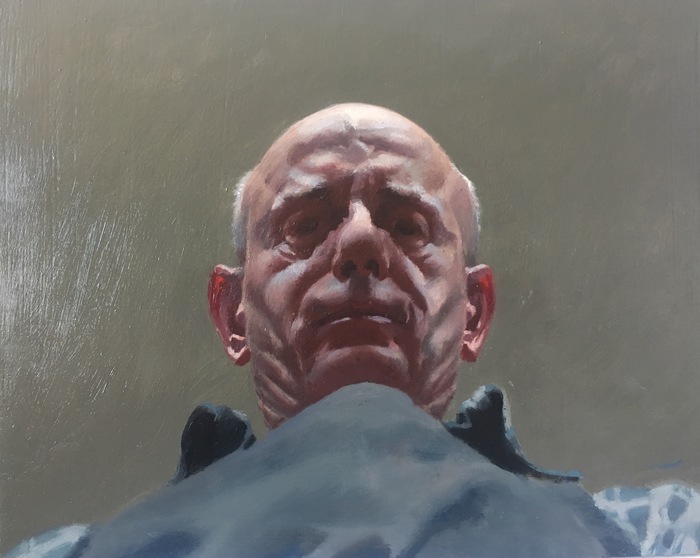Bio
Self Portrait Looking Down

Self-Portrait Looking Down
Ed Stitt has been living, painting and teaching in Boston for forty years. His work is figurative and concise, using sound drawing and a strong sense of light to convey his vision of the world.
Born and raised in western Pennsylvania, Ed first studied painting at Kent State University with Joe O’Sickey and Jack Beal. While at KSU, Ed became a Christian, which has influenced his life and art ever since. After graduation, he did portaits at Geauga Lake Amusement Park in Aurora, OH and Kennywood Park in Pittsburgh PA as he bumped around trying to figure out his next step. Thinking God must want him to be a missionary, he went to Gordon-Conwell Theological Seminary in Hamilton, MA, where the Presbyterian church asked him to examine his calling. Upon deep reflection on his motivations and gifts, Ed decided he should drop out of seminary, figuring God could use a happy painter better than an unhappy missionary. In 1983 he began taking private drawing instructions with Paul Ingbretson of the Boston School at Fenway Studios. Ed began showing his work in April 1984 at Gallery NAGA. He went on to receive his MFA in 1987 under the tutelage of Paul Rahilly and George Nick at the Massachusetts College of Art. He married in 1986; he and his new wife took up residence at Fenway Studios late in 1989. Ed began teaching at Mass College of Art in the Continuing Education department, and has been teaching in an adjunct capacity at different colleges ever since. He has had shows at Tibor de Nagy and Gallery Henoch in New York City as well as numerous one-person shows at Gallery NAGA in Boston (see Exhibition History Document attached).
Ed’s work has always been about light, contrasts, life, beauty, color, and intensity. Early in his career, he felt urban landscapes lent themselves to strong drawing and contrasts, bright colors, and juxtapositions of the natural world with the man-made. Whether portraits, still-lifes, or landscapes, Ed tries to paint the “Golden Moment” –when the subject has a timeless beauty, or is looking its best possible. More recently, Ed has come to the realization that he is no longer painting just what sees, but his "take", or interpretation of what he sees… that is, what he likes about what he sees. What occurs then is a kind of transfiguration of the normal into something greater. The results are bold, bright, strong images of local scenes around him which would not normally be considered beautiful but which become transfigured by the light and atmosphere at the particular time of day it is seen in. In this way, Ed affirms the beauty of the world we live in by focusing on that which is beautiful rather than that which is not.
Born and raised in western Pennsylvania, Ed first studied painting at Kent State University with Joe O’Sickey and Jack Beal. While at KSU, Ed became a Christian, which has influenced his life and art ever since. After graduation, he did portaits at Geauga Lake Amusement Park in Aurora, OH and Kennywood Park in Pittsburgh PA as he bumped around trying to figure out his next step. Thinking God must want him to be a missionary, he went to Gordon-Conwell Theological Seminary in Hamilton, MA, where the Presbyterian church asked him to examine his calling. Upon deep reflection on his motivations and gifts, Ed decided he should drop out of seminary, figuring God could use a happy painter better than an unhappy missionary. In 1983 he began taking private drawing instructions with Paul Ingbretson of the Boston School at Fenway Studios. Ed began showing his work in April 1984 at Gallery NAGA. He went on to receive his MFA in 1987 under the tutelage of Paul Rahilly and George Nick at the Massachusetts College of Art. He married in 1986; he and his new wife took up residence at Fenway Studios late in 1989. Ed began teaching at Mass College of Art in the Continuing Education department, and has been teaching in an adjunct capacity at different colleges ever since. He has had shows at Tibor de Nagy and Gallery Henoch in New York City as well as numerous one-person shows at Gallery NAGA in Boston (see Exhibition History Document attached).
Ed’s work has always been about light, contrasts, life, beauty, color, and intensity. Early in his career, he felt urban landscapes lent themselves to strong drawing and contrasts, bright colors, and juxtapositions of the natural world with the man-made. Whether portraits, still-lifes, or landscapes, Ed tries to paint the “Golden Moment” –when the subject has a timeless beauty, or is looking its best possible. More recently, Ed has come to the realization that he is no longer painting just what sees, but his "take", or interpretation of what he sees… that is, what he likes about what he sees. What occurs then is a kind of transfiguration of the normal into something greater. The results are bold, bright, strong images of local scenes around him which would not normally be considered beautiful but which become transfigured by the light and atmosphere at the particular time of day it is seen in. In this way, Ed affirms the beauty of the world we live in by focusing on that which is beautiful rather than that which is not.